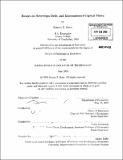Essays on sovereign debt and international capital flows
Author(s)
Basu, Suman S. (Suman Sambha)
DownloadFull printable version (8.629Mb)
Other Contributors
Massachusetts Institute of Technology. Dept. of Economics.
Advisor
Olivier J. Blanchard and Guido Lorenzoni.
Terms of use
Metadata
Show full item recordAbstract
This dissertation is a collection of three essays on public and private borrowing on international capital markets, with a focus on optimal policy for the government and international financial institutions. Chapter 1 focuses on sovereign debt and default. Recent sovereign default episodes have been associated with substantial output costs, and the sovereign should take into account that any default decision may exacerbate such costs. I construct a two-period model where sovereign debt is held by both foreign creditors and domestic residents. Default on foreign lenders benefits domestic consumption, but default on domestic residents generates an output cost that increases with the extent of the default. I present two sets of optimal policy results. Firstly, I characterize the optimal default decision and show that full repudiation of debt is not optimal when domestic output costs are sufficiently high. A corollary is that the sovereign can issue debt even in the absence of reputational mechanisms. Secondly, I show that it is optimal for the government to render the domestic economy vulnerable to the adverse effects of default, in order to raise funds cheaply from abroad. Economic fragility is an optimal response to the lack of commitment of the sovereign. Chapter 2 extends the results to an infinite horizon specification. If the default decision does not lead to reduced capital market access in the future, the results from the two-period model remain valid in the infinite horizon. (cont.) I expand the framework to incorporate persistent productivity shocks. For this case, an adverse productivity shock leads to a reduction in the feasible set of debt levels today. I show that optimal borrowing may now be increasing, rather than decreasing, in the productivity shock. Finally, I examine whether the government chooses to issue debt in the long run. If the government is allowed to save abroad and simultaneously issue government debt, then it is optimal for the government to have a positive gross debt position even in the long run, irrespective of the discount factor. The results of chapter 1 are therefore operative in the infinite horizon. Chapter 3 concentrates on private rather than public borrowing. This chapter characterizes optimal IMF policy in an environment with moral hazard followed by adverse selection. In my framework, government actions to improve domestic productivity are not always effective, and the government learns of the success of its actions before foreign investors. Without the IMF, it is not possible for foreign investors to discern the quality of the domestic production sector. There only exists a pooling equilibrium ex post, which leads to low government effort ex ante. Optimal IMF intervention is the solution to a mechanism design problem in the presence of imperfectly informed competitive markets. Optimal IMF policy is structured so as to reveal the government's private information to foreign investors in a separating equilibrium. Government effort ex ante is high. (cont.) Countries with weak fundamentals ex post accept IMF transfers and face high interest rates on private capital markets. Countries with strong fundamentals make contributions to the IMF and receive low interest rates from foreign investors.
Description
Thesis (Ph. D.)--Massachusetts Institute of Technology, Dept. of Economics, 2009. Includes bibliographical references.
Date issued
2009Department
Massachusetts Institute of Technology. Department of EconomicsPublisher
Massachusetts Institute of Technology
Keywords
Economics.